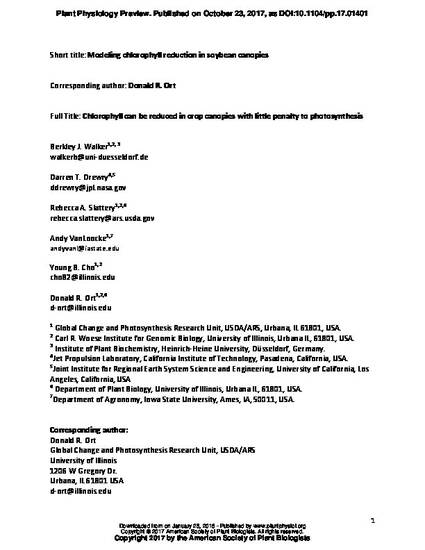
The hypothesis that reducing chlorophyll content (Chl) can increase canopy photosynthesis in soybeans was tested using an advanced model of canopy photosynthesis. The relationship between leaf Chl, leaf optical properties, and photosynthetic biochemical capacity were measured in 67 soybean accessions showing large variation in leaf Chl. These relationships were integrated into a biophysical model of canopy-scale photosynthesis to simulate the intercanopy light environment and carbon assimilation capacity of canopies with WT, a Chl-deficient mutant (Y11y11), and 67 other mutants spanning the extremes of Chl to quantify the impact of variation in leaf-level Chl on canopy-scale photosynthetic assimilation and identify possible opportunities for improving canopy photosynthesis through Chl reduction. These simulations demonstrate that canopy photosynthesis should not increase with Chl reduction due to increases in leaf reflectance and non-optimal distribution of canopy nitrogen. However, similar rates of canopy photosynthesis can be maintained with a 9% savings in leaf nitrogen resulting from decreased Chl. Additionally, analysis of these simulations indicate that the inability of Chl reductions to increase photosynthesis arises primarily from the connection between Chl and leaf reflectance and secondarily from the mismatch between the vertical distribution of leaf nitrogen and the light absorption profile. These simulations suggest that future work should explore the possibility of using reduced Chl to improve canopy performance by adapting the distribution of the "saved" nitrogen within the canopy to take greater advantage of the more deeply penetrating light.
Available at: http://works.bepress.com/andy_vanloocke/30/

This is a manuscript of an article published as Walker, Berkley J., Darren T. Drewry, Rebecca A. Slattery, Andy VanLoocke, Young B. Cho, and Donald R. Ort. "Chlorophyll can be reduced in crop canopies with little penalty to photosynthesis." Plant physiology (2017). doi: 10.1104/pp.17.01401.